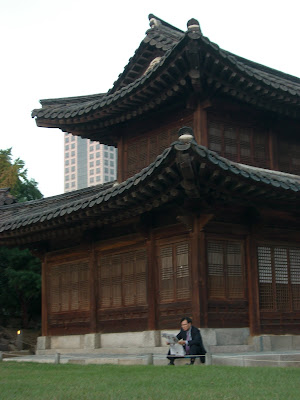Monday, October 5, 2009

Turns out I had just come across the smallest of Seoul's major palaces: Deoksugung (Palace of Virtuous Longevity). It was built in the mid-1400s during the Joseon Dynasty, the longest reigning Confucian Dynasty and the last royal dynasty in Korean history.
Inside the above building was the royal throne (below) and this building was used as the setting of official ceremonies.

The palace was originally built to be a prince's residence, but at the turn of the 17th century, the five major palaces had all been heavily destroyed by the Japanese invasion, so Deoksugung became a royal palace. It is considered to contain some of the best remnants exemplifying royal architecture. Another unique aspect to this palace is the extent to which you see the traditional architecture juxtaposed to the modern.





Much of this palace was destroyed by the Japanese during their invasion in the early 20th century, as they did with all important Korean landmarks and cultural possessions. What I saw today only constitutes 1/3 of the buildings and grounds what used to exist at this Palace, though I believe it is perpetually under slow reconstruction. If you would like to read more about the specific buildings in the photos below, click here.
The following are some decorations scattered about the grounds that I liked. First, there were many guardian goblins like this one below, and on the roof ridges there were tiny gargoyles, whose silhouette got more early as dusk fell.

The photo below was probably my favourite: its called a Singijeon, or arrow launcher, invented by Cho Museon around 1448. It shoots 100 iron-tipped bamboo arrows using paper-gunpowder rocket, with a range of 100-150 meters, depending on the size of the Singijeon.

The picture underneath is the Bell of Heungcheonsa Temple, which was forged in 1462. It's rung only once a year, for New Year's Eve. There was also an automatic striking water clock called Jagyeokru, but I didn't take a picture of it.
1 Comment:
-
- cross1celt said...
October 9, 2009 at 11:13 AMWow those are absolutely gorgeous buildings! You are lucky to be in a land so rich in art and beauty!
Subscribe to:
Post Comments (Atom)




